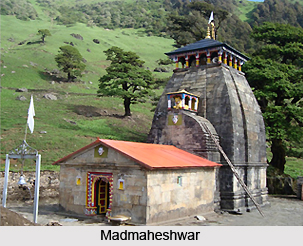Madmaheshwar, also known as Madhyamaheshwar, is a temple situated in the Mansuna village of Uttarakhand. It stands at an altitude of 3,497 ° metres and is dedicated to Lord Shiva. It is one of the five Shiva temples of Garhwal region and is the fourth temple to be visited in the pilgrimage circuit Panch Kedar. In this temple, the middle part or the belly portion of the bull is worshipped which is believed to be a divine form of Lord Shiva. Madmaheshwar is believed to have constructed by the Pandavas.
Mythology of Madmaheshwar
The legend of Madmaheshwar is a part of the legend of Panch Kedar which narrates the efforts of Pandavas to amend their sins of killing the Kauravas, their cousins, in the war of Mahabharata. The sages had advised the Pandavas to seek the blessings of Lord Shiva in order to achieve salvation. However, their conduct in the Kurukshetra war had annoyed Lord Shiva and thus he assumed the form of a bull and got hided in the Himalayan Garhwal region for avoiding them. The Pandavas were determined to seek Lord`s blessings and through their efforts found him at five places with different parts of his original avatar. Thus the Pandavas built five temples at the places where Lord Shiva revealed himself, worshipped him and attained salvation.

Architecture of Madmaheshwar
Madmaheshwar is structured in North Indian Architectural Style and stands below a high ridge in lush meadow. A Shivalinga of navel shape is enshrined in the sanctum of the temple, which is made of black stone. Two other small shrines are also installed in the temple, one of which is dedicated to Parvati and the other one to Ardhanarishvara, which is a half Shiva and half Parvati idol. The second Pandava brother, Bhima is believed to have built the temple. Besides the main temple, another small temple stands. It is dedicated to Goddess Saraswati and a marble icon of the Goddess is installed here.
Rituals of Madmaheshwar
The water of the temple premises is considered as very sacred and a few drops of it suffice for ablution. Specified times have been allotted for the start of worship in the temple. During winters when the temple becomes inaccessible due to extreme snow conditions and the symbolic icon of the god is shifted to Ukhimath, along with religious formalities, for worship. Priest of this temple belongs to South India and are known as Jangamas of the Lingayat Community from Mysore of Karnataka state. This practice enhances the cultural communications in different parts of the country irrespective of linguistic barriers. Panchasthali (five places) doctrine categorizes the temple as a significant pilgrimage centre having Shastrik (textual) importance. This categorization has been made according to offerings to the deity, fairs and festivals, sectarian association and other factors.











